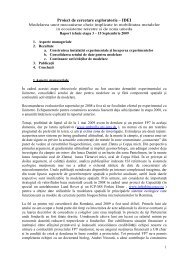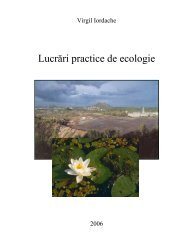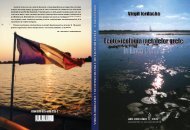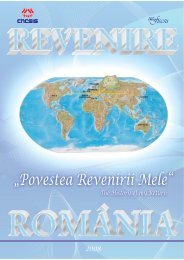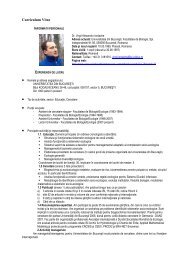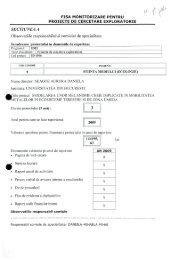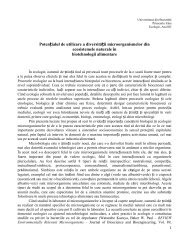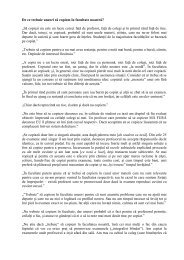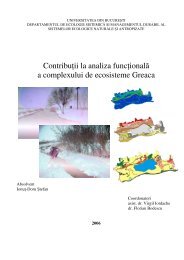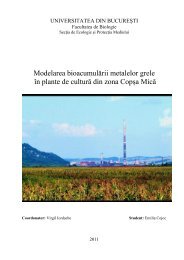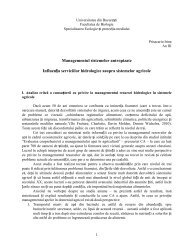PDFCreator, Job 14 - CESEC
PDFCreator, Job 14 - CESEC
PDFCreator, Job 14 - CESEC
- No tags were found...
You also want an ePaper? Increase the reach of your titles
YUMPU automatically turns print PDFs into web optimized ePapers that Google loves.
Anal. t. I.D.D.Tulcea, Romaniavol. 10 2004maximize the wealth of the society, because of the low quantity of resources which people are able toinvest in the public control of the government (op. cit.). Thus, in such countries governments have to bepersuaded be other means to increase the quality of the services that they provide to the society. Theaspects relevant to such persuasion are: pointing out the favorable elements for lobbying the integratedmanagement of LDF, establishing the tactical objectives, delineating the tactical plan.Favorable elements for lobbying are:1. Most diked areas are economically inefficient;2. The International Commission for the Protection of Danube River already promotes restoration;3. Foresters have strong lobbying capacity and might be interested in the integrated management;4. There is experience in designing the integrated management both in Danube Delta and the SmallIsland of Braila (INCDDD Tulcea and University of Bucharest);5. Other research and development institutions might be interested to be involved in designing theintegrated management plan of LDF started from existing work, and consequently in the lobby (“LowerDanube University” of Galati, Academy Institute of Biology IBIOL, Academy Institute of Geography,Research and Development Institute for Environmental Protection – ICIM Bucuresti, RomanianInstitute for Marine Research)6. IAD [6] is committed to be involved in the conservation of the floodplain along the Danube and itstributaries;7. RAMSAR and WWF have strong lobbying capacity, and might be interested in the lobbying for theintegrated management of LDF;8. International financial sources (GEF, UNDP, UNEP, World Bank) tend to promote projects ofintegrated development.Tactical objectives could be:1. The integrated management of the Lower Danube Fisheries to become a stated goal at the RomanianGovernment level; next2. The development of integrated management plans of key diked areas as part of a complex integratedmanagement plan of LDF to become priority for the Romanian Government in view of internationalfinancingThese objectives can be seen as part of the Action Plan for the implementation of the National Strategy forSustainable Development [29]As for the tactical plan for achieving the objectives we propose a systems approach consisting in couplinga bottom-up approach (from local level to Romanian Government) with a top-down approach (from ICPDRto the Romanian Government).The bottom up approach would include:• constructing a core task force including the mentioned research and academic institutions;• attracting forestry research in this task ;• developing a project for attracting the local administration of LDF SESs in the taskforce; these projectcould be run in consortium by the institutional partners, or by a widely recognized professionalorganization (such as, for instance, the Romanian Society of Ecology);• identifying viable alternative of livelihood for farmers at local level by running specific projects;• applying in consortium for local funding a major research project for advancing in the design of theintegrated management plan;• keeping a high profile in the media and developing contacts with NGOs capable of adding value to theexisting group of partners;• contacting the main political parties for promoting the adoption of the tactical objectives.It is known that the short time span of the governments’ life limit their appetite to take practical initiativeson the long term, unless there are no clear media benefits for the involved parties and politicians. Thus,the task force should focus not only on scientific aspects, but must have a strong interface to public and ahigh profile in the media.Financing of the task force can be done in the first phase by the involved partners to cover humanresource input and communication costs. In the second phase special costs can be included in theprojects developed by the local consortium. Competition of local institutions for local and internationalfunding which generally limit the formation of local consortiums, should be given up to the maximumpossible extent, because the societal role of scientist is not only to do science and obtain directadvantages from this, but also to promote general human values as reflected in the public good. Formationof local consortiums which are further integrated in international consortiums is feasible, as demonstratedby recently financed EU projects [12]. Thus, scientists belonging to different institutions should normally be



